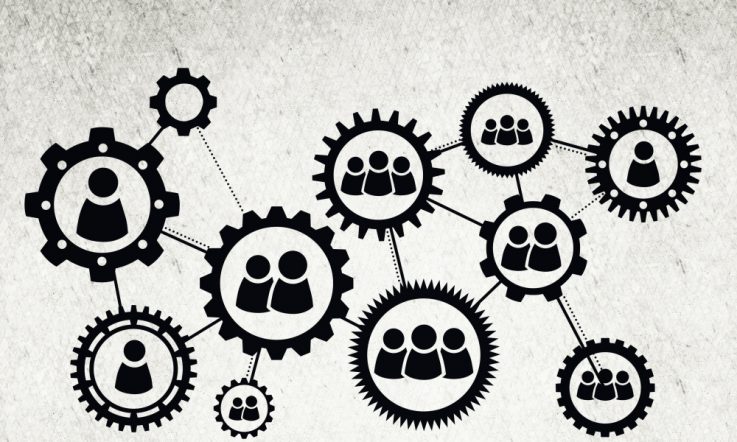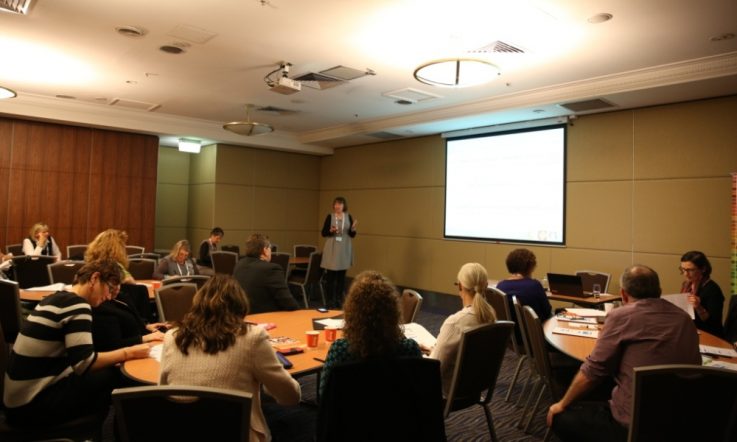We recently shared the story of a Queensland school that has implemented individual development plans for teachers after a series of professional learning workshops on the spiral of inquiry with Dr Helen Timperley.
What is the spiral of inquiry? And, how can this approach to professional learning be used to support the complex work of leaders and teachers, and improve student learning?
Teacher spoke to Timperley (Professor Emeritus of Education at the University of Auckland) and colleagues Dr Fiona Ell (Associate Dean and Head of Teacher Education), Dr Deidre Le Fevre (Head of Graduate Programs in Educational Leadership), and Dr Kaye Twyford (Lecturer in Educational Leadership) to find out more.
What is the spiral of inquiry and, typically, who is involved?
The spiral of inquiry is a systematic process for investigating and improving learner outcomes; academic, social and wellbeing. There are many calls for teachers to use inquiry as part of their practice because of its associations with improved outcomes for marginalised learners. It has potential for challenging the sometimes invisible assumptions that keep ineffective practices going despite professional learning initiatives or the reading of books or provision of resources to teachers. Sometimes these calls for improvement come with cycles for inquiry, outlining the steps teachers and leaders should take to make inquiry happen.
The spiral of inquiry provides a framework for teachers and leaders to use, but it makes it clear that it is an ongoing process rather than a one-off cycle that is engaged with and then put aside until ‘next time'. The spiral of inquiry is a tool for changing mindsets and fundamental approaches to what it is to teach and lead in schools.
Because of its intention to make these fundamental shifts, it works when everyone is involved, starting with the learners. This starting point is imperative. The experience of using the spiral to improve learner outcomes is a collaborative one, where leaders, teachers and learners work together throughout the process. For many schools it works best when everyone, from the teachers of the youngest learners to the teachers of the oldest learners, work together with a shared student focus.
Can you take readers through each of the six stages?
The stages: are scanning; focusing; developing hunches; learning; taking action; and, checking. Each has an important part to play in the success of the spiral.
The spiral always begins with students. Scanning is about gathering information about students' experiences and looking at it together, asking questions, seeking patterns and deepening understanding based on evidence from learners. The evidence might be about academic outcomes, using tools such as PAT (Progressive Achievement Tests) or NAPLAN (the National Assessment Program – Literacy and Numeracy), or diagnostic tests of mathematics or reading comprehension. Or it might be about engagement, emotional safety, feelings of belonging, wellbeing, friendships or relationships within the school. Ideally, it is about both because they are so closely related. In the scanning phase teachers and leaders are seeking to understand ‘what is happening for our learners?'.
In the focusing phase, the teachers and leaders choose a focus from their scanning activities. Many things may have emerged from scanning – now the task is to select one focus for the in-depth inquiry process. It is really important that the focus is clear, and tight. Having scanned a lot of information, finding a tight focus can be challenging – it seems like there are lots of important things to do – but one of the key principles of the spiral is using a tight focus to make change, and then the new learning from that focus spreads to other areas of practice. Without a tight focus, motivation and energy dissipates and little changes.
The third phase of the spiral involves developing hunches about how we as teachers and leaders may be contributing to the current situation. Many people who have used the spiral report that this phase is key to the spiral's success. Leaders and teachers brainstorm all the reasons why they think the situation is as it is. How are we contributing to our learners not progressing past addition in mathematics? Is it the way we are teaching reading that leads our students to struggle to understand what they read? Why are we experiencing difficult behaviours during play-based learning sessions? Is it something to do with the way we are setting them up? The aim here is to get all the assumptions we make out on the table – some of these involve long-held beliefs, so the conversation can be challenging, but this phase is critical to moving forward.
In the learning phase, the teachers and leaders identify what they will need to learn in order to do things differently with respect to the focus. For example, if the focus is reading comprehension, investigating hunches may uncover that teachers are not confident in how to teach reading comprehension. In the learning phase expertise from within the school, or external expertise, can be used to help teachers and leaders build their skills and knowledge.
The taking action phase is when the teachers and leaders begin using their new knowledge to change practice and improve learner outcomes – and the checking phase is where they gather information about the impact of their changed practice and examine it to see if it is working for the learners.
These last three phases – learning, taking action, checking – often form a mini spiral as the work progresses, with teachers and leaders returning to learning, trying something, checking its impacts and then learning some more. It is important that the checking occurs as the work proceeds, not at the ‘end', when it is too late to act if the change has been ineffective. This is where an evaluative mindset needs to come in: through using the spiral, teachers and leaders come to question their impact, seek evidence, be open to further learning and remain intensely curious about what is happening for learners all the time.
From your own extensive work with schools, what are some of the common challenges leaders and teachers face when progressing through these stages?
The key challenge of working in schools is finding time. In the case of the spiral, leaders and teachers need to not just find time, but make time – by putting aside some of their other activities in order to deeply enact the spiral. The research is very clear – the more things school try to improve at once, the less improvement is actually achieved. Keeping the ‘main thing the main thing' is very challenging in a demanding environment, but it is essential to making real progress. Leaders need to set aside meeting times and make space for the talk and sharing that makes the spiral work. As the process unfolds, not getting distracted is critical.
Sometimes leaders approach the spiral believing they have the answers for their teachers. For example, students are not actively taking responsibility for their learning, so the answer is for teachers to engage in professional development in formative assessment. This stops everyone genuinely inquiring into what is going on for their learners and how they, as professionals, may be contributing to the situation. In reality, a number of issues may be contributing to this situation, including the culture leaders have created throughout the school that is preventing teachers and students from learning deeply what they need to learn. Neither may believe the students are capable of taking such responsibility as a result of unconscious bias.
Another common challenge is getting lost in the spiral – as changes in practice are implemented new questions arise, and teams can get confused about what stage they are at and what they are doing. The spiral is flexible and ‘mini spirals' can occur, so leaders and teachers need to be using the approach as a mindset, rather than an inflexible, linear path that must be followed in a particular way. The risk in this – and another common challenge – is that leaders and teachers never reach the checking phase. Instead, they begin again pursuing new directions. It is really important to ‘close the loop' and check if you've actually made a difference, and sticking to this rather than beginning on a new issue does require discipline!
School leaders and teachers obviously play a key role, but how much involvement should students have and why is this important?
Students are at the heart of the spiral. The spiral is grounded in their experiences, exists to improve their lives and learning and is driven by their responses. Students can, and should, be involved in lots of ways. In schools where we have worked, students have worked alongside teachers to discuss data patterns, provided their thoughts and feelings about subjects or the experience of school and have worked with teachers to reflect on the outcomes of the spiral. Student voice is commonly the catalyst for change when schools engage with the spiral – until they hear from the students in their own voices, some teachers remain distant or cynical. The students provide powerful evidence of the need for change. So, gathering and using student voice is essential to the spiral's effectiveness. Involving them in creating change gives them agency and a stake in the improvement process.
Can spiral of inquiry be used in other contexts, or is it intended only to be used in relation to professional learning?
We have worked with networks of school leaders who have engaged in a leadership spiral across a number of schools experiencing common challenges. In this situation, the focus of the scanning question, ‘What's going on for our learners?' is the teachers. What are their experiences that are leading to a particular situation across the schools that is impacting on the student learners? It is still important to link the experiences of the teachers with those of the students.
Some schools are also using the spiral at the student level. They are asked in the scanning phase ‘What is going on for me as a learner?', ‘Am I taking responsibility for my learning?', ‘Am I feeling safe in this learning environment?'. Then they are encouraged to focus on one thing they can do to change things in relation to their achievement, social relationships or wellbeing. At the hunch phase, they ask, ‘How am I contributing to what is happening?' with new learning, taking action and checking following.
Leading change and improvement is a complex task for principals. What are some of the challenges they face in this area?
School leaders have a complex task. In a school there are many directions they might take or problems they need to solve – and they can't do this alone, so a key part of the role is taking others with them. In our book Leading Professional Learning: Practical strategies for impact in schools, we have tried to identify some of the key challenges that we have seen school leaders face, and to provide some examples and ideas about ways to address these challenges. Because school change is complex it comprises interdependent pieces – things are linked together in important ways, so changing one thing will change others – sometimes in unexpected ways. Recognising this is the first challenge. An issue with reading progress in Year 2 has its origins in K-1 reading and has consequences for later years. As well as teacher practice issues, there may be resource and timetable issues, or support issues, unrecognised changes in student needs (for example, more children learning to read in their second language). Seeing problems holistically in this way is the beginning of seeking more enduring solutions – through processes such as the spiral of inquiry.
This isn't easy work, with challenges inevitably part of the process. We have highlighted the key challenges we have noted as the chapters of the book: dealing with complexity; maintaining coherence; building a learning culture; addressing equity and bias; recognising risk and dealing with emotional responses; and using evidence and evaluative thinking. Schools are busy places with multiple agendas. Clearing the decks and making time are critical first steps.
“Keeping the ‘main thing the main thing’ is very challenging in a demanding environment, but it is essential to making real progress.” As a school leader, how do you ensure you and your team remain focused on the issue you’ve identified? What are some of the most common distractions you face?
When working on an improvement issue, how do you check if you’ve made a difference? Do you always see the current plans through before pursuing a new direction?
Leading Professional Learning: Practical strategies for impact in schools, by Helen Timperley, Fiona Ell Deidre Le Fevre and Kaye Twyford, is published by ACER Press and available to pre-order now via this link. It will be released on 2 December, 2019.



